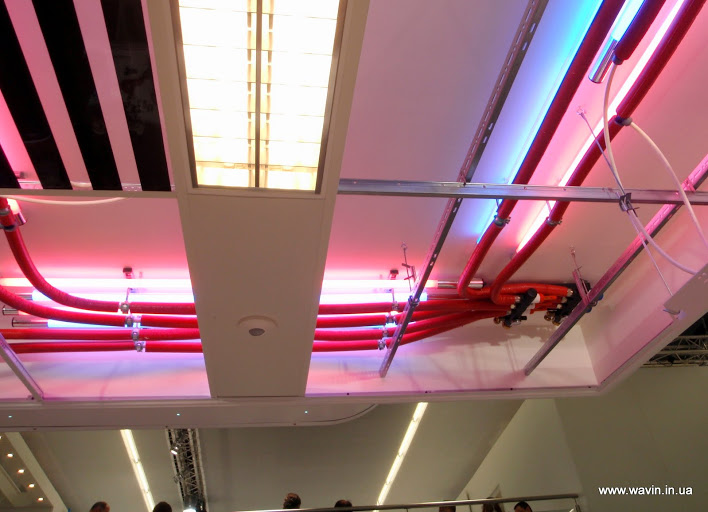
Radiant heating/cooling systems
Use of radiant microclimate systems (RMS) is an innovative solution for heating and cooling to provide maximum comfort.
There is one of the most significant differences of surface heating and cooling from other similar ones, this is ENERGY EFFICIENCY. The system is designed for operation with low-temperature heat transfer agent. For example, in heating mode, the temperature of the water supplied to the system should be within +40… +50 oC. This makes the system an ideal solution in the case of use of renewable energy, such as solar collectors and heat pumps.
The main benefits of RMS:
— healthy indoor environment;
— heating and cooling are obtained from one system;
— saves energy and operating costs;
— freedom of design, absence of heat radiators;
— quick response to the commands of controller (heating and cooling);
— provides comfortable temperature conditions in a room.
Due to its modular design, this system is ideal solution for both new construction and renovated buildings.
There are two kinds of RMS:
THERMAL PANELS. The complete panels with integrated pipes that are designed for installation on ceiling or wall.
THERMAL CONCRETE CORE ACTIVATION. This is a technology of installation of prefabricated piping modules inside the concrete ceiling of a building, during construction.
Radiant heating and cooling
Demand for energy-efficient technologies of heating and cooling of houses is growing: nowadays a building must meet strict environmental criteria, as well as high requirements to energy efficiency. This concerns to both new buildings and renovated ones. Moreover, RMS is the system that provides both heating and cooling, and therefore is more efficient than traditional heating and air conditioning.
The thermal panels mounted in a ceiling are the most effective solution for cooling purposes, rather powerful and very comfortable. But this system is also able to heat the room during offseason. It can provide heating from the ceiling even in winter, if the heat losses of this room are low, i.e. the building has excellent thermal insulation.

Naturally, the output of ceilings, walls and floors for heating and for cooling are significantly different. This is illustrated in the following table (calculated for room temperature 20°C in heating mode and for 26°C in cooling):

Heat transfer by radiation
Any surface-based system (floor/wall heating, ceiling cooling) realizes radiant principle of heat transfer, which is more efficient than traditional convective systems: Radiation interacts only with people and objects in the room, without spending energy for the whole volume of air. The action of radiation can be compared with the blows of ping-pong balls. In a collision with an object, they cause a reaction, either give heat (for heating) or absorb it (cooling).
By the way, radiation heat transfer is as old as the World: the Sun gives us its heat in the same way.
The perfect solution for microclimate
Radiant microclimate system can be used in any building, from apartments or offices on the ground floor, to nursing homes or hospitals. There are two main conditions of expediency of implementation of RMS:
- Low heat loss (heat gain) of a room. Or, in another words, the room must have excellent thermal insulation;
- Availability of free space in the interior for installing heating/cooling surfaces. It is important to provide maximum square for RMS on ceiling (for cooling), on walls and floor (for heating).
Thermal activation system for concrete core

Thermal core activation system consists of prefabricated piping modules for integration inside the concrete ceiling of a building, during construction. The installed system provides complete solution for comfort heating and cooling. Air conditioners, radiators and underfloor heating become unnecessary if the specific heat loss/gain (W/m2) of the building meet modern standards, i.e. small.
The system sets the specified room temperature within 45 minutes starting from the controller’s command. This is rather quick response to control for such an inertial heat exchanger as concrete overlap.
In comparison with other systems, thermal core activation consumes less energy, as well as reduces operating costs.
Thermal panels

Thermal panels give us the freedom of interior design.
The ceiling with thermopanels can be covered with almost any material, including ceiling panels made ??of gypsum, which are available with or without joints and in different patterns and colors. Also, metal panels have a growing popularity. Some European manufacturers even offer special solutions for hospitals and nursing homes – the thermal panels with antibacterial coating.
Hereinafter are the components necessary for installation of radiant microclimate systems:
— distribution manifolds;
— actuators for regulating and shut-off valves;
— multilayer pipes with anti-diffusion coating;
— controllers for optimal control;
— digital thermostats and humidity regulators;
— humidity (dewpoint) sensors.


Aquatherm PE offers project management services: engineering design, coordination of joint work of subcontractors and installation work.
Please contact us on matters of RMS:
Roman Tchaikovsky,
Renewable Energy Project Manager,
Cell: +38-098-456-44-00,
T/F: +38-044-255-16-99,
rt[at]viessmann.com.ua
Aquatherm PE,
1-A, Sadova 49th str., Kyiv, 02132, Ukraine

